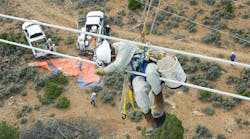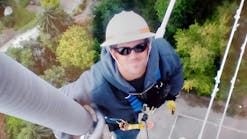Taking a line out of service can be costly for a utility as well as time-consuming for field crews. To improve productivity, Tri-State Generation and Transmission (G&T) first delved into live-line work more than 30 years ago. And although the linemen have been practicing barehand and hot-sticking procedures for decades, it was not until recently that they began using a new method for barehanding called rope access.
Tri-State, which serves Colorado, Nebraska, Wyoming and New Mexico, covers a large territory with mountainous regions and hard-to-access work sites. It’s nearly impossible for linemen to transport heavy equipment to field sites without a substantial amount of bulldozer and road work. To minimize the impact on the environment and the wildlife, the journeymen learned how to access the conductors with the use of rope and modern mountaineering equipment.
Training Linemen
Before implementing its rope access/rescue program, Tri-State created a training team consisting of Clint White, the lineman apprenticeship trainer, and four journeymen linemen from the east, south and west sides of the service territory.
Tri-State then hired Palo Verde Rope Works to provide training. The Phoenix, Arizona-based rope access/rope rescue training company, which is owned by John Sheriden, an expert in rope access and rescue, is well versed in rope and mountain climbing technology, rescue techniques and access techniques with rope.
The utility also partnered with long-time live-line trainer Jim McDonald, who worked for A.B. Chance as a live-line demonstrator and now serves as a private live-line instructor for transmission companies. Tri-State combined the experience of McDonald and Palo Verde Rope Works to provide live-line training sessions for the journeymen.
Through a week-long rope training course, the journeymen had the opportunity to try out the different types of harnesses, climbing gear and other tools used in the rope access and rope rescue world. The trainers also set up a simulation in the Montrose, Colorado, training facility to get the linemen accustomed to the type of work they would be performing with the rope access method. The instructors put up all the rigging on a 345-kV dead-end, double-circuit tower, and the journeymen had to use rope to access energized transmission lines and bond on without the use of ladders or barehand-rated trucks.
After completing the initial training session, the journeymen must attend a yearly course to maintain certification in barehand work. The utility sponsors three different live-line barehand training schools each year. For example, the trainers offer two-week classes in different parts of the service territory to ensure that all of the linemen are trained and certified to perform the work. In addition, linemen are required to work 40 hours a year using the rope access method and 40 hours a year on the live-line barehand hot-stick program. In most cases, the linemen are able to far exceed this requirement with all the work that they are doing out in the field.
The utility’s five live-line trainers travel to the different areas to train the journeymen on barehand, rope access, hot-sticking and rescue techniques. The program is set up as a Train-the-Trainer program, in which the instructors are trained first, and then they disseminate this information to the field. As these trainers go out into the field, they continue to learn more about the barehand, live-line and rope access methods.
This core group of trainers, which has worked together for the last four years, is now not only training and certifying the journeymen, but also rewriting a live-line maintenance manual and compiling a new barehand manual for the field crews. The trainers are also working on developing methods for the company’s new rope access/rescue barehand program, which is at the forefront of what Tri-State is doing when it comes to barehand work.
Implementing the New Work Practice
In the past, Tri-State’s linemen would safety off to a ladder or a truck to perform barehand work. Often, the linemen had to perform the repair or construction work in a remote location, where infrastructure had been in place for more than 30 years. As such, it was often difficult for the field crews to reach the job site because of a lack of roads or rugged terrain.
If the linemen were using a heavy piece of equipment such as a crane or lift, they had to create a pad around the tower, use a bulldozer to clear the roads and then perform re-vegetation work to mitigate any impact to the land or water runoff. Compounding the problem, the linemen had to monitor the leakage current on the trucks and ladders to protect their coworkers who were performing the barehand work. Finally, the linemen had to operate costly equipment, which was at risk for being damaged while they were trying to access some of the remote locations.
In addition, the Tri-State linemen had to rely on ladders to perform barehand work. Moving these heavy ladders to a remote work site was no easy feat. When the linemen had to work miles from the hot-stick trailer, they had to place the ladders on the back of a pickup truck or all-terrain vehicle. Once the ladders arrived on site, then a crew had to work together to install the ladders and set them up on the towers. Like with the trucks, the linemen also had to worry about leakage current with the ladders when performing barehand work.
By using the rope access method, the linemen have a limited amount of equipment. To protect themselves on the energized infrastructure, the journeymen wear a barehand suit from Euclid Garment Manufacturing. This suit is made of Nomex with stainless-steel mesh threads that are woven into the cloth fibers. The suit creates a “Faraday Cage” effect to keep the linemen safe while performing barehand work on energized lines.
In addition to the barehand suit, the linemen also use mountaineering-type blocks and a special flame-retardant mountaineering climbing harness designed by Yates Harness Co. The linemen also use a new type of rope that is different from standard rope linemen normally use because it is a small, yet strong, kern mantle rope. The anchoring and attachment systems also help the linemen to ascend, descend and brake while performing the rope access work.
When performing the rope access method, the linemen use the towers as anchor points in the air and trucks as anchor points on the ground. The linemen on the ground measure the constant tension of the rope, pulling the linemen off the ground and up to the conductor using a trolley system.
Saving Time in the Field
While some utilities have specialized live-line crews, all of the journeymen who work for Tri-State are live-line trained and barehand and hot-stick certified.
At Tri-State, all of the journeymen have the opportunity to bond to the conductor. In addition, they can also train in the methods of rope access/rope rescue, which is an important part of any barehand program. Because the experience level of the journeymen can vary so significantly, however, the utility is still trying to find ways to include all of its journeymen in the complex task of rope access barehanding.
In the last year-and-a-half, the linemen have used the rope access method to work on 345-kV and 230-kV suspension “V” strings, perform dead-end work and repair gunshot conductors located away from the towers. The linemen were able to do this work safely in a short amount of time with no need to replant vegetation or build roads.
Although safety is the most important factor when doing live-line work, rope access has cut down the time to perform live-line work significantly by eliminating the need to install booms and ladders on towers.
In addition to increasing their productivity, Tri-State linemen now have more tools in their tool box to perform live-line work in a variety of different situations and locations. For example, in situations where they would traditionally need to de-energize a line, haul heavy equipment to a work location or secure enough manpower to haul hot sticks into the site, Tri-State linemen now only need a bag of rope and a small amount of gear to access the hot end of a conductor.
The increase in the linemen’s productivity also has helped Tri-State save money. While safety is first and foremost for the utility, it’s also important to improve the efficiency of the field crews whenever possible. The cost of the rope access equipment is much less than what is required for other live-line methods, allowing all the journeymen linemen to learn about this new work method.
Also, by working barehand using the rope access method, the journeymen linemen are able to minimize their impact on the environment, save time in the field, and ultimately get more work done safely in less time, therefore increasing reliability for Tri-State’s customers.
Tom Penner ([email protected]) is a journeyman lineman and one of Tri-State Generation and Transmission’s barehand live-line trainers. He has spent more than 25 years in the power industry and learned his trade with Pacific Gas & Electric Co. and Tri-State G&T. He works out of Craig, Colorado, and helps to maintain the transmission system in northwest Colorado. His fellow live-line trainers are Joe Trevizo, John Fournier, Kevin Brown and Clint White.
Companies mentioned:
Euclid Garment Manufacturing Co. | www.euclidgarment.com
Palo Verde Ropeworks | www.pvropeworks.com
Tri-State Generation and Transmission | www.tristategt.org
Yates | www.yatesgear.com




